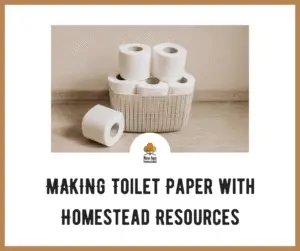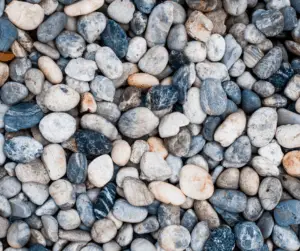Believe it or not, toilet paper could be considered a luxury more than a necessity. This is not to say that the cleaning of that area on the body is not essential.
But we humans have survived for a long time without those soft, multiply squares.
You may draw a blank when thinking of ideas on how to make toilet paper or its alternatives because this topic is not something we often think about.
However, you may be surprised by the number of ways in which toilet paper can be made with the resources around your home.
I should note that many of the suggestions in the following article are not how to physically make toilet paper from scratch.
Rather they are ways to make toilet paper by repurposing common resources found around most homesteads.
If the time comes that you have used your last square or you are wanting to be less wasteful, read on to find out how to make your own homemade toilet paper.
11 Ways to Make Toilet Paper at Home
I need to begin by saying that none of the following toilet paper options should be flushed down your toilet. Doing so may cause clogs or damage to your toilet and pipes. Flush at your own risk!
Newspaper
Using newspaper in this manner is actually one of the better options available and there are three different ways in which to use it.
The first way is to simply cut the sheets of paper into small squares that measure around five to six inches on each side.
The squares can then be placed in a bathroom and used as-is.
The second way is to cut the sheets of paper in half or quarters. When it is needed, crumple the sheet up into a ball. This is a more effective way of carrying away waste than option number one.
The third method is a bit more involved and produces a material that is like toilet paper. The newspaper is shredded, immersed in water, mixed up, and allowed to dry in a large sheet. Squares are then cut out to the desired size and stacked in a bathroom.
The result is a firm piece of material that almost resembles cardboard. The material can be softened beforehand by lightly misting it with water, which will make it more effective at carrying away waste. A walkthrough of how to make this material can be viewed here.
Cloth Squares
This is one of the best ways in which to make homemade toilet paper because it provides a soft, absorbent, effective means of cleaning.
Cloth squares are also super cheap, easy to make, and reusable!
To begin, all you will need is a soft material like cotton or flannel, and a pair of scissors.
Old cotton t-shirts, flannel shirts or blankets, and socks work extremely well.
Use the scissors to cut the material into squares that measure four to six inches on each side. The squares can then be neatly stacked next to the toilet to be used.
After the squares have been used, they can be discarded into a trash receptacle. However, one benefit of using this type of material is that squares can be washed and reused.
Simply have another container in the bathroom that the soiled squares can be placed into until wash day. To avoid bad odors, make sure the container has a lid that can seal!
Whole Garments
Cutting cloth squares will give you more bang for the buck. But if you do not want to go through the hassle of cutting a bunch of squares, there is another option.
Smaller cloth articles like socks, washcloths, and hand towels can be used as-is without having to cut them up.
Just like the above example if you plan on reusing the material you will need a container and lid that seals.
Household Paper Products
There are several paper products that most homes have that can be used for the purpose of toilet paper.
Items that work well for this include:
- Coffee filters
- Napkins
- Facial tissues
- Paper towel
- Paper
These products should not be washed or reused once they become soiled and should be disposed of in a trash receptacle.
Nature’s TP
When doing your business outdoors or wishing to use natural materials, mother nature will provide.
Leaves
This is nature’s number one go-to toilet paper material.
Leaves are abundant, soft, and come in a variety of sizes.
Green leaves are better to use over dead leaves because they hold together well. Dead leaves break apart easily and will leave you with a bigger mess than you started with so do not even try using them.
When you find the type of leaves you want to use, it is best to test them out first before committing them to the main task.
This is to ensure you will not have any type of reaction to a particular leaf. If you do react to a particular leaf it is better to find out about it beforehand on a small part of your arm rather than on your backside.
To do this, rub a leaf on a small area on the inside of your forearm. Wait at least an hour to see if there is any type of reaction such as redness, swelling, or itchiness.
If there is no reaction, break the leaf open and rub some of the juices on a small area of your forearm. Wait another hour to see if there is any reaction.
If no reaction occurs, then the leaf should be okay to use. However, if any kind of reaction happens then that type of leaf should be discarded. Continue your quest until you find a suitable candidate.
Pinecones
Your first thought with this option might be, “ouch!” But pinecones really are not all that bad to use and some are softer than others.
If you find using a pinecone a little uncomfortable, try turning the cone so that the woody scales are pointed downward.
Corncobs
This is an option not often brought up, but I have heard of more than a few people who have used corncobs in this manner when they were growing up.
The cob will first have to be prepared by removing all the corn and then allowed to dry. The dried cob can then be placed into a container where one, two, or three of them can be grabbed before doing your business.
Rocks
Wait a minute…rocks? Surely, I cannot be serious? Oh, but I am.
You do not want to grab a handful of gravel for this task because then you will be saying “ouch!”
The rocks you are going to want are river rocks because their surface is incredibly smooth.
Finding one or two rocks of adequate size, shape, and smoothness will provide a way of wiping away waste for eons to come.
Snow, Soil, Sand
These are resources that every homestead will have that work moderately well.
A handful of firm soil or wet sand can be used to collect waste and the soiled material can then be disposed of.
The downside is that soil and sand can be messy, uncomfortable, and leave you feeling not as clean.
A handful of compacted snow, though frightfully cold, will leave the area much cleaner than soil or sand.
Squeeze Bottle
This is not a material for wiping away waste like most of the above suggestions, but it is a tool that can help clean oneself.
Before conducting your business fill the bottle with water of the desired temperature. Avoid water that is cold or hot as that would make the process uncomfortable.
Warm water would be best in terms of comfort and washing waste away.
Other water containers like a water bottle could be used, but a squeeze bottle is ideal. This is because it directs water flow while at the same time providing water pressure to clean the area more efficiently.
Materials to Stay Away From
- A handful of short grass clippings
- Dead leaves
- Abrasive materials
- Smooth fabrics like silk
- Overly fuzzy material like yarn
- Glossy publications like magazines
Wrap Up
Likely, most people do not like to think about this topic, let alone talk about it. Yet, everyone goes to the bathroom every day.
The reality is that some people wish to handle this task in a less wasteful or renewable manner or to be prepared for a situation in which commercial toilet paper is just not available.
Either way, a homestead has a lot of different resources to make toilet paper to deal with this everyday task.
Are there some other ways to make toilet paper on a homestead that we forgot to mention? Sound off in the comment section below and let us know!




